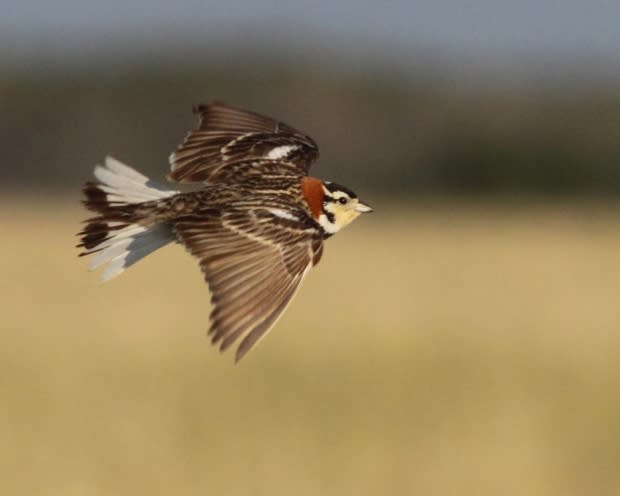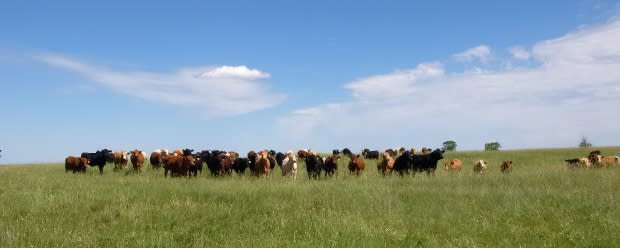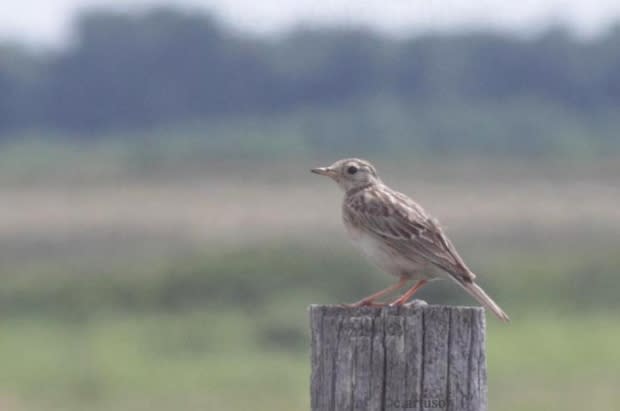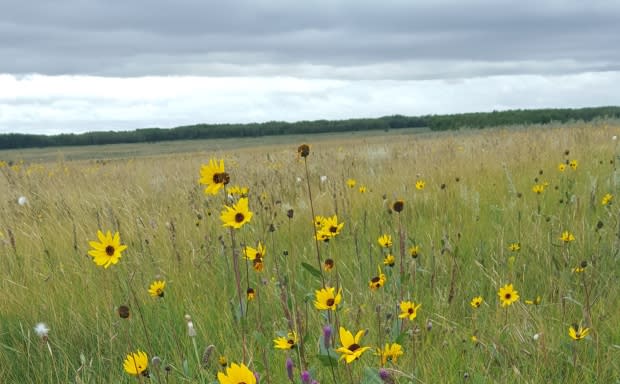Manitoba-Saskatchewan pastures home to endangered species declared important bird area
An exceedingly rare kind of grassland in Manitoba and Saskatchewan — and the endangered birds and plants that call it home — are getting a little symbolic protection.
Nature Manitoba, Bird Studies Canada and Nature Saskatchewan designated the Ellice-Archie and Spy Hill community pastures as important bird and biodiversity areas this week.
"It's one of few places in this province now that you can really get a grasp of what the Prairies used to look like — this grassland that stretches across the horizon," said Tim Poole, co-ordinator of the Manitoba Important Bird Areas Program.
The important bird and biodiversity area designation and the IBA program itself don't necessarily confer any hard protections, but Poole hopes it raises the profile of the area and makes governments and the public more aware of the rarities worth protecting in their backyard.

It's Manitoba's 36th important bird and biodiversity area, and the first to cross from Manitoba into another province.
The Ellice-Archie pasture is near Birtle and St. Lazare, with a small river valley to the west and the Assiniboine River running along the eastern perimeter. The Spy Hill pasture is just north of it, near Spy Hill, Sask., tucked between the Qu'Appelle and Assiniboine river valleys.
'Sense of pride'
Zane Fredbjornson is one of two land managers in charge of grazing on the pastures. His father managed land in the same area, and he takes his responsibility to the cows, land and wildlife seriously.
"Some of the last remaining native grasses that we have in Canada, to me that's important, and being on these lands and working on them, it just gives you a sense of pride," he said.

He said the important bird and biodiversity area designation means a lot, because it's a sign that his sustainable approach to grazing is being recognized.
"It tells me that they basically feel like I've done the right thing in working with this land. I'm not taking more than what I should be."

The community pastures are a breeding ground for two species of global concern: the chestnut-collared longspur and the Sprague's pipit. There were 146 pipits and 230 longspurs detected in the pastures in separate surveys in 2017 and 2015, respectively, qualifying the birds as globally significant, says Birdlife International.
The Manitoba side also attracts the provincially endangered Baird's sparrow every spring and is home to 10 uncommon or rare Manitoba plant species, including Indian rice grass and waxleaf beardtongue.
'Not quite so beneficial'
Oil and gas, mining, hydro development and the spread of invasive species all pose an ongoing threat in the area, said Poole.
"Having this site designated as an important bird area is really encouraging for us because … there's lots of interest in it from external sources which, let me say, [are] not quite so beneficial for the birds," he said.

There is a potash mine that borders a section of the Saskatchewan side that raises fears about how future mineral extraction could impact the wildlife, Poole said.
The subsurface part of the area also falls within the Bakken oilfields, Poole said, and only half of the area's subsurface land rights are owned by the Crown.
"It's been described to me like a checkerboard," he said. 'It's obviously the non-Crown land subsurface rights where we see a threat to the native prairie."
The group also raised concerns with the province and Manitoba Hydro in 2017 over plans to run the Birtle transmission line through the centre of the Spy Hill pasture. The main sticking point in that case, Poole said, has more to do with habitat fragmentation than habitat loss.
'Losing our native prairies'
Lots of the more sensitive threatened and endangered grassland birds need vast expanses of unaltered native mixed-grass prairie to thrive. When something like a transmission line slices through those habitats, it creates a hunting corridor that exposes ground-nesting species to predators, Poole said.
"We need people to start understanding, outside of our small conservation bodies, how important and precious these habitats are," Poole said.
"We call ourselves a Prairie province, yet we are losing our native prairies … fast."

Over 75 per cent of all such grasslands have disappeared Canada-wide, and Manitoba has lost even more mixed-grass habitat than other provinces, Pool said.
"It highlights the issues facing native prairie, not just here but elsewhere," he said. "Native prairie is an endangered ecosystem."
The development of roads, towns and buildings and the proliferation of agriculture led to the widespread destruction.
Fields of native grasses were converted to crop lands that may look like the average prairie field, but grassland songbirds have a more discerning eye and are very picky about what kinds of grasses they will nest in. That's one reason why they're now one of the most threatened bird groups in North America.
Drought-ravaged pastures
The Ellice-Archie and Spy Hill grasslands were preserved when community pastures were formed after years of drought in the 1930s ravaged crops on the Prairies. Native plants tend to be more drought-resistant, the Manitoba Important Bird Areas Program website says, so alternative land use practices started to be implemented.
The federal government used to look after these pastures, but Ottawa divested management duties to the provinces in recent years. The Association of Manitoba Community Pastures now oversees 20 community pastures totaling 140,000 hectares (350,000 acres) of land throughout Manitoba.

The Ellice-Archie and Spy Hill pastures contain 125 plant species and the largest intact native mixed-grass prairie in Manitoba, said Rachel Whidden, range and project manager for the Association of Manitoba Community Pastures.
The association works with local livestock producers by taking their cattle out onto the pasture lands to graze, rotating groups around different sections throughout the summer. Moving the cows around a lot limits the impact they have on the delicate grasslands, and by not letting the them linger in any one area for too long, land managers end up replicating the ecological effects that roaming bison used to have on the plains.
Cattle fertilize the soil and leave a quality of "patchiness" on the grassland ecosystem that produces hiding places and prime habitat for ground-nesting birds and insects.

Fredbjornson, who as a land manager is in charge of moving cows around the pastures, said the mistakes of past agricultural practices and other development have had a lasting toll on the landscape.
"We've abused areas," he said. "They can be fixed. It's not impossible, it just needs the right management."
He understands how precious and connected his surroundings are and intends to do what he can to ensure they stay that way.

"To me …what better place in the world can you live?" he said. "It's a very harmonious environment out there."
"Everything is important out here," he said.
"It's important that the grass is there for the cows. It's important that the grass is there for the birds. It's important that we keep the sandy soil covered so we don't go backwards on what we have here."


